Research on Surface Morphology of Gold Micro Bumps Based on Monte Carlo Method
Abstract
:1. Introduction
2. Simulation Method and Model Establishment
2.1. Simulation Method
2.1.1. Deposition Event
2.1.2. Migration Event
2.1.3. Calculation Method for Deposition and Migration Event Probability
2.1.4. Simulation Algorithm Flow
- (1)
- Initialize the substrate structure and calculate the deposition rate Rd and migration rate Rh arrays.
- (2)
- Calculate the probability of each event Pi.
- (3)
- Generate a random number 0 < rand1 < 1 by a random number algorithm.
- (4)
- Compare the deposition event probability Pd with the random number rand1, and if rand1 < Pd, select the deposition event; otherwise, the migration event is selected.
- (5)
- Execute the selected migration event or deposition event.
- (6)
- Update the coordinate array and event probability array of migrated or deposited particles and particles in the immediate vicinity.
- (7)
- Repeat steps 2–7 until the set number of deposited particles is reached.
- (8)
- Output and count the position coordinates of all particles in the system, calculating the simulation results.
2.2. Computation Models
3. Analysis and Results
3.1. The Effect of a Single Factor on Surface Roughness
3.1.1. Effect of Deposition Voltage on Surface Morphology
3.1.2. Effect of Plating Temperature on Surface Morphology
3.1.3. Effect of Ion Concentration on Surface Morphology
3.2. The Effect of Multiple Parameters on Surface Roughness
3.2.1. Effect of Deposition Voltage and Ion Concentration on Roughness
3.2.2. Effect of Deposition Voltage and Plating Temperature on Roughness
3.2.3. Effect of Plating Solution Temperature and Ion Concentration on Roughness
4. Conclusions
- (1)
- From the perspective of the single-factor, lower deposition voltage, lower ion concentration and higher plating solution temperature can help reduce the number of empty spaces and isolated islands on the surface of the electrodeposited layer, resulting in a flat and smooth surface topography.
- (2)
- From the perspective of the multi-factor, the simulation show that the deposition voltage and deposition temperature have a greater effect on the surface RMS roughness and play a dominant role, while the ion concentration has a smaller effect on the RMS roughness.
Author Contributions
Funding
Data Availability Statement
Conflicts of Interest
References
- Kim, C.; Kim, D.H.; Jeong, W.; Kim, H.J.; Park, I.H.; Park, H.W.; Lee, J.; Park, J.; Ahn, Y.L.; Lee, J.Y.; et al. A 512 Gb 3 b/cell64-stacked WL 3D V-NAND flash memory. In Proceedings of the 2017 IEEE International Solid-State Circuits Conference (ISSCC), San Francisco, CA, USA, 5–9 February 2017; Volume 60, pp. 202–203. [Google Scholar]
- Liu, Y.; Zhang, Z. Carbon based electronic technology in post-Moore era: Progress, applications and challenges. Acta Phys. Sin. 2022, 71, 7–42. [Google Scholar] [CrossRef]
- Hao, J.S.; Xiang, W.W. Three dimensional heterogeneous integration and application of microsystems. Electron. Process Technol. 2018, 39, 317–321. [Google Scholar]
- Zhu, X.; Zhou, Y.; Liu, Y. Development status and trends of microelectronic information system. Audio Eng. 2021, 45, 21–29. [Google Scholar]
- Lau, J.; Li, M.; Li, Q. Design, materials, process, fabrication, and reliability of fan-out wafer-level packaging. IEEE Trans. Compon. Packag. Manuf. Technol. 2018, 8, 991–1002. [Google Scholar] [CrossRef]
- Hou, S.Y.; Chen, W.C.; Hu, C.; Chiu, C.; Ting, K.C.; Lin, T.S.; Wei, W.H.; Chiou, W.C.; Lin, V.J.; Chang, V.C.; et al. Wafer-Level Integration of an Advanced Logic-Memory System Through the Second-Generation CoWoS Technology. IEEE Trans. Electron Devices 2017, 64, 4071–4077. [Google Scholar] [CrossRef]
- Chen, W.C.; Hu, C.; Ting, K.C.; Wei, V.; Yu, T.H.; Huang, S.Y.; Chang, V.C.Y.; Wang, C.T.; Hou, S.Y.; Wu, C.H.; et al. Wafer level integration of an advanced logic-memory system through 2nd generation CoWoS technology2017 Symposium on VLSI Technology. In Proceedings of the 2017 Symposium On Vlsi Technology, Kyoto, Japan, 5–8 June 2017. [Google Scholar]
- Zhou, G.; Cao, Z. Technics of microbump and TSV for 2.5D package technology. Micro Process 2017, 38, 15–18. [Google Scholar]
- Gutt, T.; Schulze, H. Deep melt activation using laser thermal annealing for IGBT thin wafer technology. In Proceedings of the 2010 22nd International Symposium on Power Semiconductor Devices & IC’s (ISPSD), Hiroshima, Japan, 6–10 June 2010; pp. 29–32. [Google Scholar]
- Hwang, Y.; Pan, C. Numerical analysis of the welding behaviors in micro-copper bumps. Metals 2021, 11, 460. [Google Scholar] [CrossRef]
- Zhou, M.; Zhao, X.; Chen, M.; Ke, C.; Zhang, X. 2 Size effects of growth and evolution of interfacial intermetallic compound and the mechanical behavior of bump structure Sn3.0Ag0.5Cu/Cu cross-scale joints in electronic packages. J. Mech. Eng. 2022, 58, 259–268. [Google Scholar]
- Wu, D.; Tian, W.; Wang, C.; Huo, R.; Wang, Y. Research of wafer level bonding process based on Cu–Sn eutectic. Micromachines 2020, 11, 789. [Google Scholar] [CrossRef]
- Lu, Q.; Zhang, J.; Zeng, C.; Wang, H.; Dong, D.; Wen, Z.H.; Wen, J.L.; Jiang, M.; He, Q.L. Micro-bumps technology for RF SiP. Electron. Process Technol. 2020, 41, 249–251. [Google Scholar]
- Lau, J.; Li, M.; Li, Q. Fan-Out wafer-level packaging for heterogeneous integration. IEEE Trans. Compon. Packag. Manuf. Technol. 2018, 8, 1544–1560. [Google Scholar] [CrossRef]
- Liu, Y.; Tamura, N.; Kim, D.W. A metastable phase of tin in 3D integrated circuit solder microbumps. Scr. Mater. 2015, 102, 39–42. [Google Scholar] [CrossRef] [Green Version]
- Liu, Y.; Chu, Y.C.; Tu, K.N. Scaling effect of interfacial reaction on intermetallic compound formation in Sn/Cu pillar down to 1μm diameter. Acta Mater. 2016, 117, 146–152. [Google Scholar] [CrossRef]
- Cho, Y.; Hahn, M.; Jeong, H.; Jang, G. Shear test evaluation of the mechanical reliability of micro bumps in semiconductors. Microsyst. Technol. 2022, 28, 2173–2180. [Google Scholar] [CrossRef]
- Tian, W.; Li, Z.; Cheng, C.; Li, W.; Chen, Z.; Xin, F.J.M. Hydrogen storage performance of-graphdiynedoped Li based on firstprinciples for Micro/Nano. Micromachines 2022, 13, 547. [Google Scholar] [CrossRef]
- Liang, X.; Li, X.; Yao, P.; Li, Y.; Jin, F. Effects of plating parameters on fabrication of micro-bump in 3-D integration. Inf. Midem 2017, 36, 79–85. [Google Scholar]
- Ren, X.F.; An, M.Z. Theoretical and experimental studies of the influence of gold ions and DMH on cyanide-free gold electrodeposition. Rsc. Adv. 2018, 8, 2667–2677. [Google Scholar] [CrossRef] [Green Version]
- Lee, J.M.; Bae, K.M.; Jung, K.K. Creation of micro structured surfaces using Cu-Ni composite electrodeposition and their application to superhydrophobic surfaces. Appl. Surf. Sci. 2014, 289, 14–20. [Google Scholar] [CrossRef]
- Stach, S.; Sapota, W.; Ţălu, Ş.; Ahmadpourian, A.; Luna, C.; Ghobadi, N.; Arman, A.; Ganji, M. 3-D surface stereometry studies of sputtered TiN thin films obtained at different temperatures. J. Mater. Sci. Mater. Electron. 2017, 28, 2113–2122. [Google Scholar] [CrossRef]
- Xin, R.E.N.; Zhang, Y.; Jiaru, T.I.A.N.; Haoxin, W.A.N.G.; Botian, C.H.A.I.; Chao, M.E.N.G. Microstructure and properties of Ni-nano TiC composite coating prepared by different electrodeposition methods. Acta Mater. Compos. Sin. 2022, 39, 4093–4101. [Google Scholar]
- Zhou, X.F.; Wu, C.; Tang, C.Y.; Kong, C.G. Kinetic Monte Carlo (KMC) simulation of thin film growth. J. Synth. Cryst. 2012, 41, 792–797. [Google Scholar]
- Liu, J.; Liu, C.; Conway, P.P. Kinetic Monte Carlo simulation of the electrodeposition of polycrystaline copper: Effects of substrates and deposition parameters on the microstructure of deposits. Electrochim. Acta 2013, 97, 132–142. [Google Scholar] [CrossRef]
- Treeratanaphitak, T.; Pritzker, M.D.; Abukhdeir, N.M. Atomistic kinetic Monte Carlo simulations of polycrystalline copper electrodeposition. Electrochem. Commun. 2014, 46, 140–143. [Google Scholar] [CrossRef] [Green Version]
- Treeratanaphitak, T.; Pritzker, M.D.; Abukhdeir, N.M. Kinetic Monte Carlo simulation of electrodeposition using the embedded-atom method. Electrochim. Acta 2014, 121, 407–414. [Google Scholar] [CrossRef] [Green Version]
- Kaneko, Y.; Mikami, T.; Hiwatari, Y. Computer simulation of electrodeposition: Hybrid of molecular dynamics and Monte Carlo. Mol. Simul. 2005, 31, 429–433. [Google Scholar] [CrossRef]
- Nishimura, S.; Kaneko, Y.; Hiwatari, Y.; Ohara, K.; Asa, F. Molecular simulation approach to the effects of additives in electrodeposition process. ECS Trans. 2009, 16, 83–92. [Google Scholar] [CrossRef]
- Martin-Bragado, I.; Borges, R.; Balbuena, J.P.; Jaraiz, M. Kinetic Monte Carlo simulation for semiconductor processing: A review. Prog. Mater. Sci. 2018, 92, 1–32. [Google Scholar] [CrossRef]
- Chason, E.; Bower, A.F. Kinetic Monte Carlo simulations of stress and morphology evolution in polycrystalline thin films. J. Appl. Phys. 2019, 125, 115–304. [Google Scholar] [CrossRef]
- Doyama, M.; Kogure, Y. Embedded atom potentials in fcc metals. Radiat. Eff. Defects Solids 1999, 14, 80–83. [Google Scholar] [CrossRef]
- Hao, F.; Verma, A.; Mukherjee, P.P. Electrodeposition stability of metal electrodes. Energy Storage Mater. 2019, 20, 1–6. [Google Scholar] [CrossRef]
- Röder, F.; Braatz, R.D.; Krewer, U. Direct coupling of continuum and kinetic Monte Carlo models for multiscale simulation of electrochemical systems. Comput. Chem. Eng. 2019, 121, 722–735. [Google Scholar] [CrossRef]
- Li, P.; Yang, Z.; Zhao, H. Growth conditions of Cu thin-films grown by CVD using kinetic Monte Carlo simulation. Chin. J. Quantum Electron. 2015, 32, 364–370. [Google Scholar]
- Tian, W.; Li, B.; Li, Z.; Cui, H.; Shi, J.; Wang, Y.; Zhao, J. Using Chiplet Encapsulation Technology to Achieve Processing-in-Memory Functions. Micromachines 2022, 13, 1790. [Google Scholar] [CrossRef]
- Kwak, B.H.; Jeong, M.H.; Kim, J.W.; Lee, B.; Lee, H.J.; Park, Y.B. Correlations between interfacial reactions and bonding strengths of cu/sn/cu pillar bump. Microelectron. Eng. 2022, 86, 65–69. [Google Scholar] [CrossRef]
- Chen, Z.; Cao, Y.; Tian, W.; Wang, Y. Surface roughness analysis of Cu films deposited on Si substrates: A molecular dynamic analysis. J. Appl. Phys. 2019, 126, 045303. [Google Scholar] [CrossRef]
- Kim, B.H.; Chung, Y.C. Atomic-level investigation for surface characteristics in a Co-Cu multilayer system: Molecular dynamics simulation. IEEE Trans. Magn. 2008, 44, 2903–2906. [Google Scholar]
- Ghezali, K.; Mentar, L.; Boudine, B.; Azizi, A. Electrochemical deposition of ZnS thin films and their structural, morphological and optical properties. J. Electroanal. Chem. 2017, 794, 212–220. [Google Scholar] [CrossRef]
- Pan, J.L.; Huang, M.L.; Zhao, N. Microstructure of Au-Sn eutectic bumps prepared by sequential electroplating. Chin. J. Nonferrous Met. 2012, 22, 2016–2022. [Google Scholar]


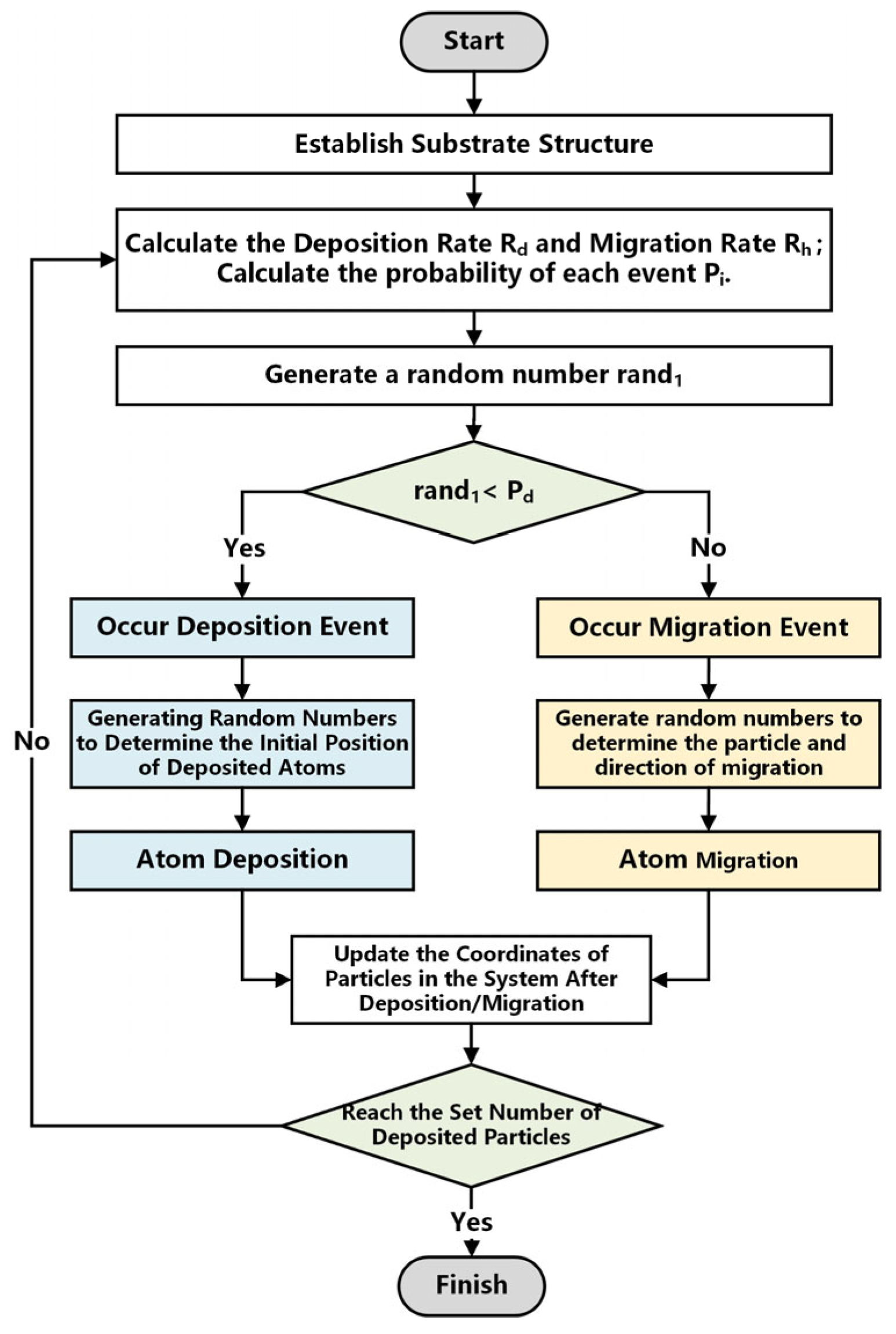
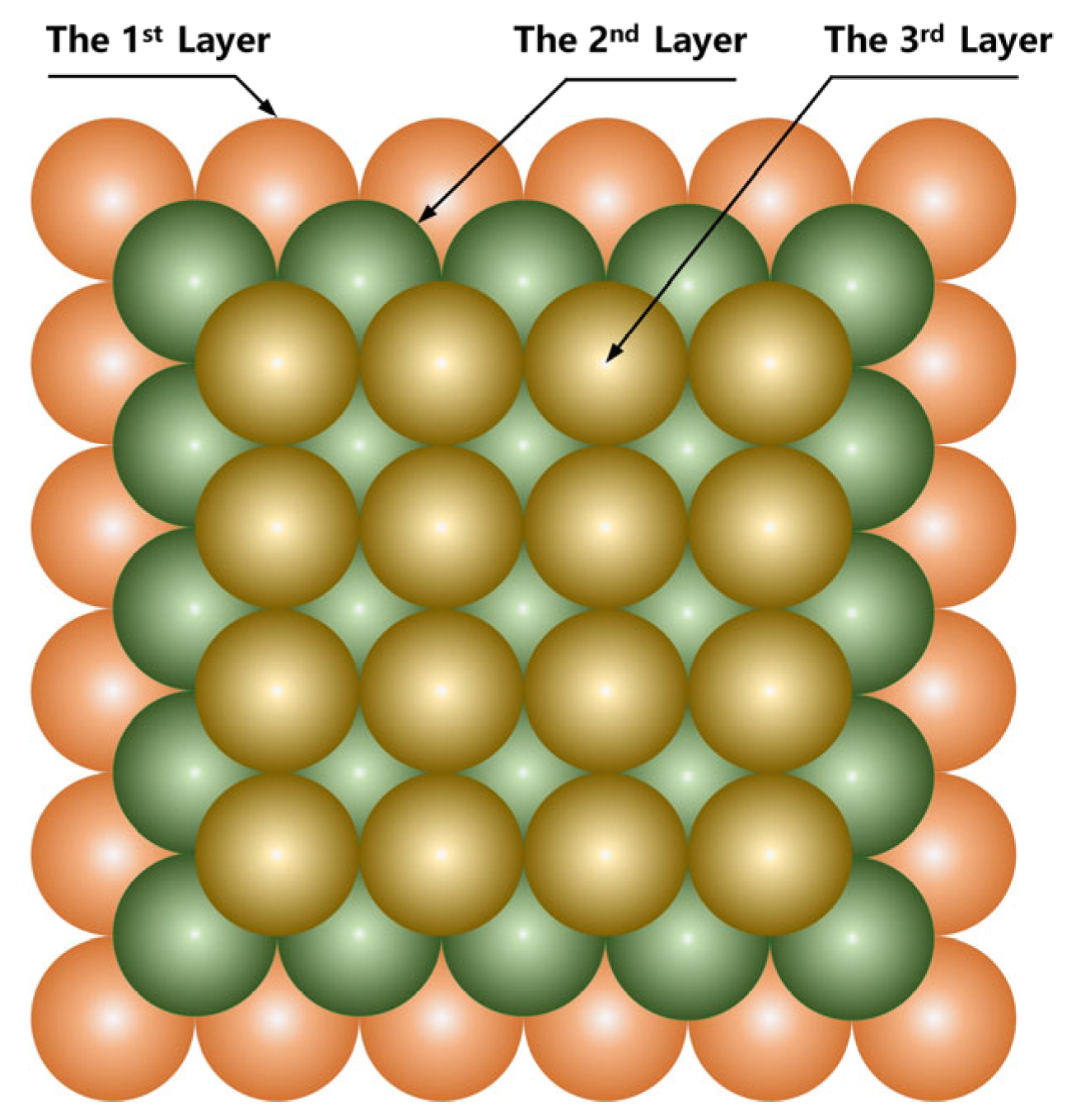
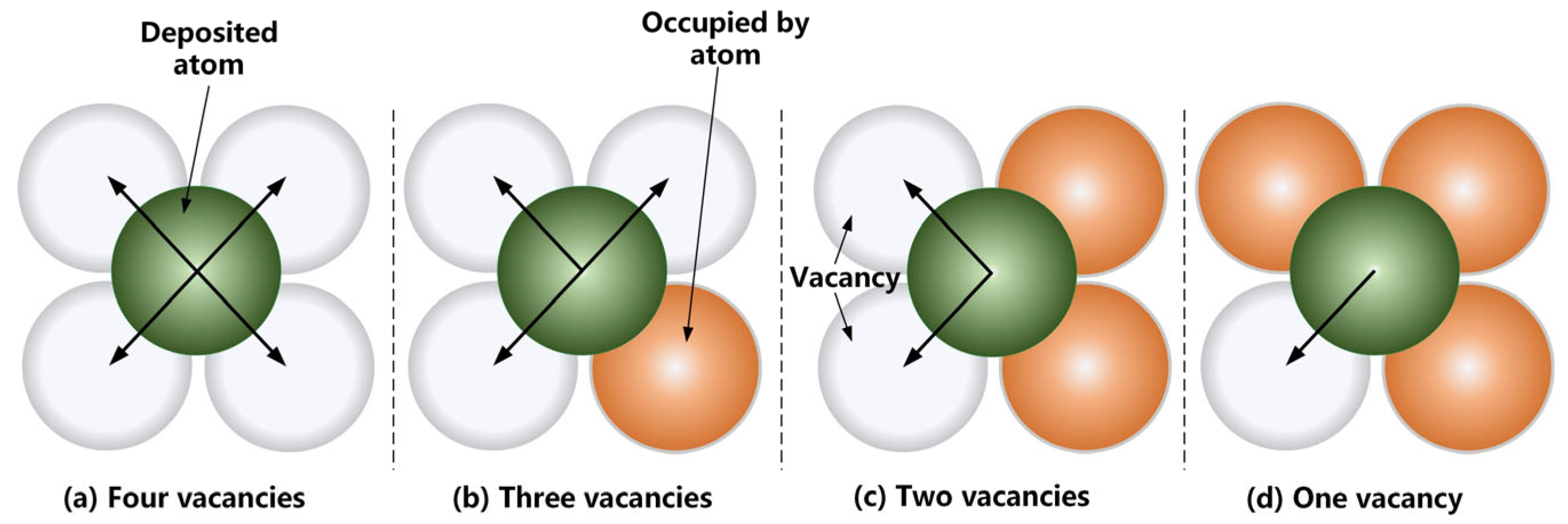

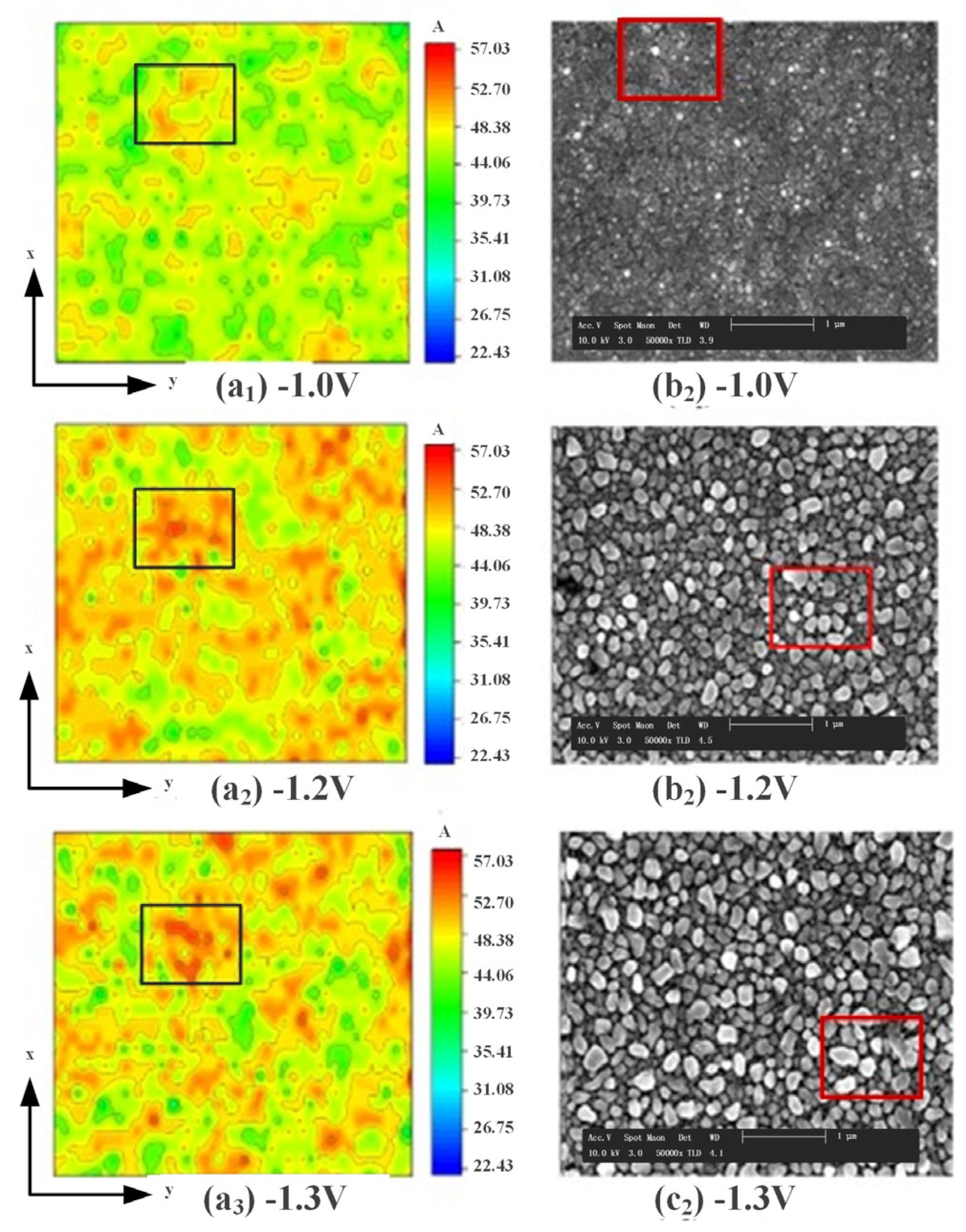
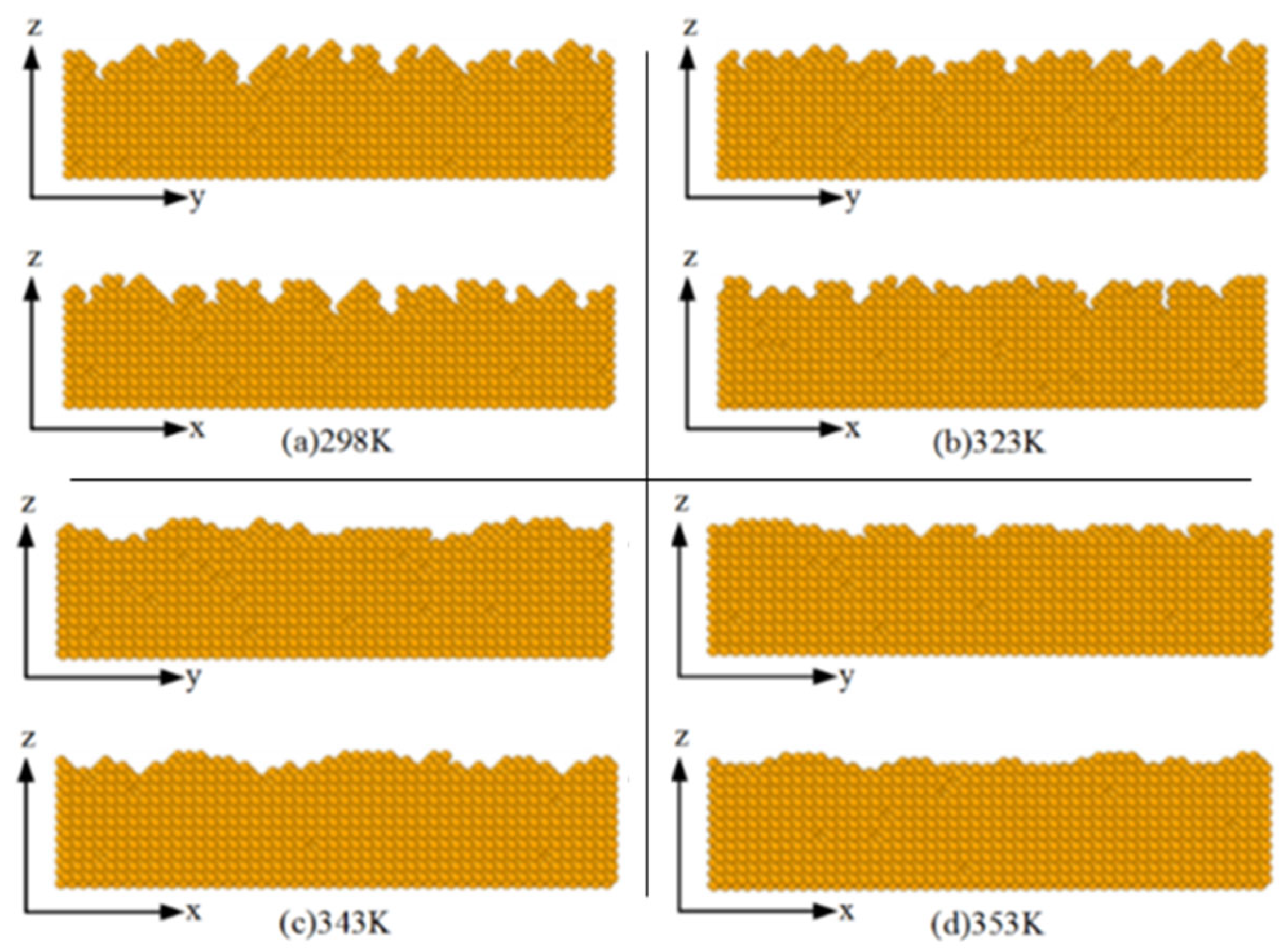


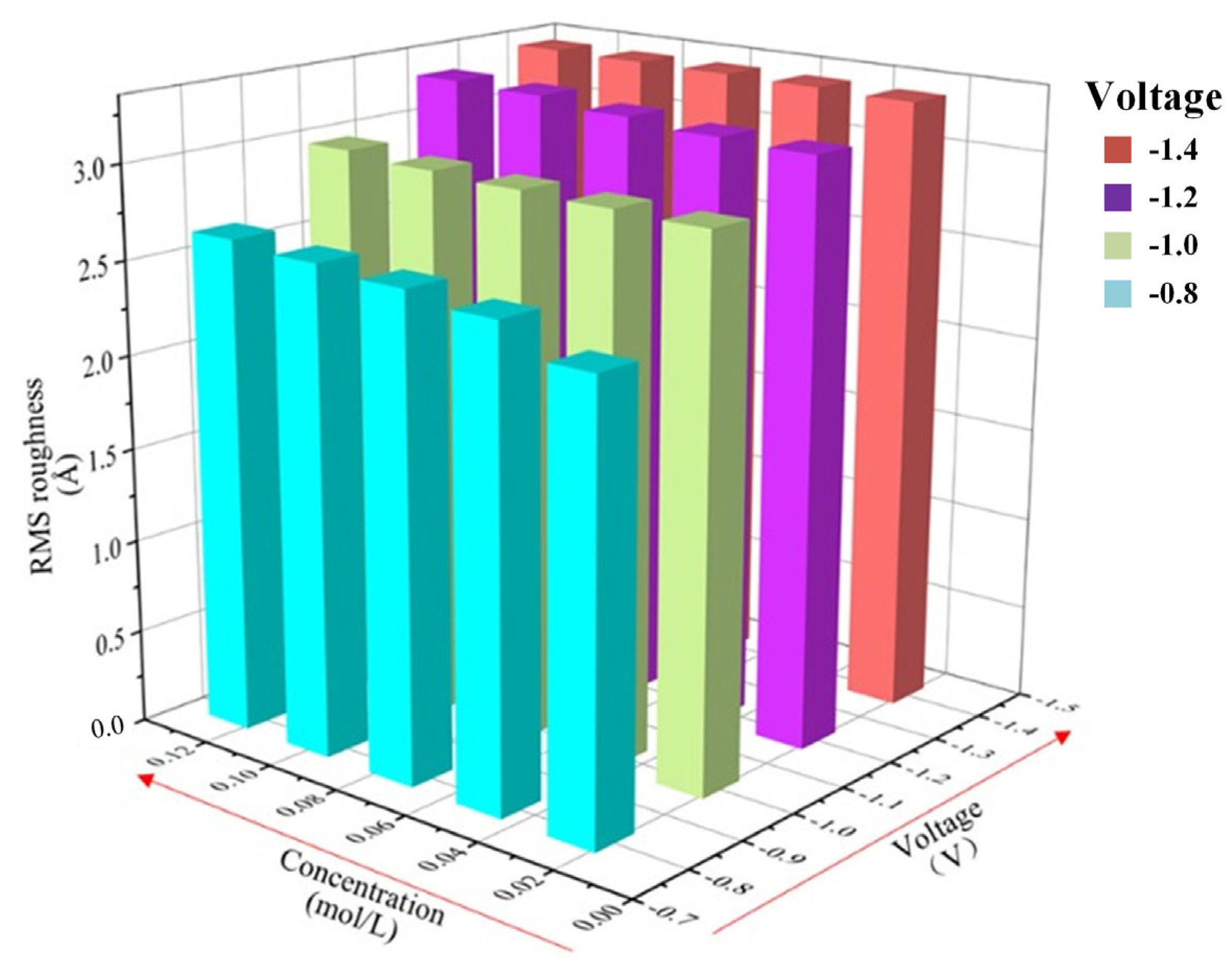


| Model Parameter | Values |
|---|---|
| A1 | 518,021.8789 |
| A2 | 0.0183 |
| c1 | 15.5770 |
| c2 | 1.2867 |
| D | 11.9318 |
| Number | Symbol | Set Value | Description |
|---|---|---|---|
| 1 | Ndep | 50,000 | Number of deposited Au atoms |
| 2 | a | 14.419 nm | Length of the base in the X direction |
| 3 | b | 14.419 nm | Length of the base in the Y direction |
| 4 | Km | 0.2 × 10−3 m3/mol·s | Chemical reaction rate constant |
| 5 | Fa | 96,485.338 C/mol | Faraday constant |
| 6 | R | 8.314 J/mol·K | Ideal gas constants |
| 7 | α | 0.5 | Conversion coefficient |
| 8 | n | 1 | Ionic charge number |
| 9 | T | 298 K~358 K | Plating temperature |
| 10 | V | −0.8 V~−1.4 V | Deposition voltage |
| 11 | Cm | 0.025 mol/L~0.125 mol/L | Ion concentration |
| Voltage (V) | −0.8 | −1.0 | −1.2 | −1.4 | |
|---|---|---|---|---|---|
| Concentration (mol/L) | |||||
| 0.025 | 2.3631 | 2.8953 | 3.1283 | 3.2813 | |
| 0.05 | 2.5166 | 2.9084 | 3.1444 | 3.2925 | |
| 0.075 | 2.5699 | 2.9219 | 3.1798 | 3.2998 | |
| 0.1 | 2.6039 | 2.9430 | 3.2230 | 3.3030 | |
| 0.125 | 2.6364 | 2.9743 | 3.2361 | 3.3078 | |
| Voltage (V) | −0.8 | −1.0 | −1.2 | −1.4 | |
|---|---|---|---|---|---|
| Temperature (K) | |||||
| 298 | 2.8917 | 3.1483 | 3.3173 | 3.3532 | |
| 313 | 2.6769 | 3.0547 | 3.2481 | 3.3309 | |
| 328 | 2.5166 | 2.9064 | 3.1454 | 3.2925 | |
| 343 | 2.2763 | 2.6752 | 3.0363 | 3.2347 | |
| 358 | 2.2179 | 2.4903 | 2.8901 | 3.1591 | |
| Concentration (mol/L) | 0.025 | 0.05 | 0.075 | 0.1 | |
|---|---|---|---|---|---|
| Temperature (K) | |||||
| 298 | 3.1975 | 3.2143 | 3.2232 | 3.2359 | |
| 313 | 2.9890 | 3.1358 | 3.1577 | 3.1673 | |
| 328 | 2.8953 | 2.9164 | 2.9256 | 2.9430 | |
| 343 | 2.6262 | 2.8182 | 2.8507 | 2.8583 | |
| 358 | 2.3571 | 2.4909 | 2.5421 | 2.5623 | |
Disclaimer/Publisher’s Note: The statements, opinions and data contained in all publications are solely those of the individual author(s) and contributor(s) and not of MDPI and/or the editor(s). MDPI and/or the editor(s) disclaim responsibility for any injury to people or property resulting from any ideas, methods, instructions or products referred to in the content. |
© 2023 by the authors. Licensee MDPI, Basel, Switzerland. This article is an open access article distributed under the terms and conditions of the Creative Commons Attribution (CC BY) license (https://creativecommons.org/licenses/by/4.0/).
Share and Cite
Ji, H.; Tian, W.; Qian, H.; Sun, X.; Wang, Y.; Gu, L.; Zheng, L. Research on Surface Morphology of Gold Micro Bumps Based on Monte Carlo Method. Micromachines 2023, 14, 1345. https://doi.org/10.3390/mi14071345
Ji H, Tian W, Qian H, Sun X, Wang Y, Gu L, Zheng L. Research on Surface Morphology of Gold Micro Bumps Based on Monte Carlo Method. Micromachines. 2023; 14(7):1345. https://doi.org/10.3390/mi14071345
Chicago/Turabian StyleJi, Haoyue, Wenchao Tian, Hongwen Qian, Xiaodong Sun, Yongkun Wang, Lin Gu, and Lihua Zheng. 2023. "Research on Surface Morphology of Gold Micro Bumps Based on Monte Carlo Method" Micromachines 14, no. 7: 1345. https://doi.org/10.3390/mi14071345




